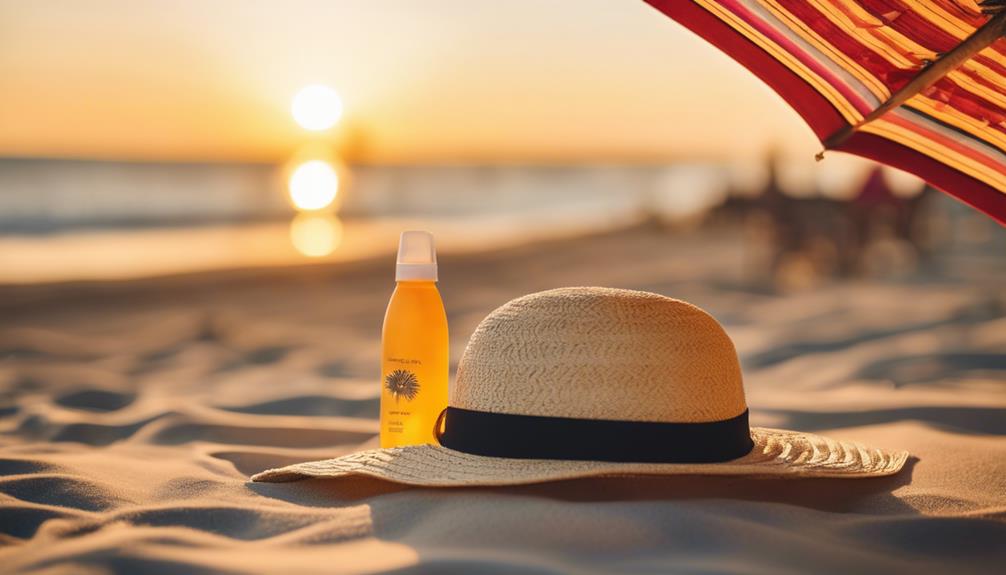Sunburn is caused by UV radiation damaging skin cells, resulting in inflammation and redness. The severity of sunburn varies depending on skin type, as categorized in the Fitzpatrick scale, which ranges from highly sensitive (Type 1) to more resilient (Type 6). Production of melanin by melanocytes offers some protection; however, all skin types are still vulnerable. Misconceptions such as the effectiveness of base tans or tanning beds can worsen the issue. Effective sun protection includes using broad-spectrum sunscreen, seeking shade, and wearing protective clothing. Understanding these factors can help you maintain healthier skin and reduce future risks.
Key Takeaways
- Sunburn occurs due to UV radiation causing cellular damage, leading to redness and inflammation of the skin.
- Higher skin types (5 and 6) have more melanin, which provides better natural protection against sunburn.
- Symptoms of sunburn include redness, pain, peeling, and in severe cases, blistering.
- Prolonged UV exposure increases the risk of DNA damage and skin cancer, regardless of skin type.
Understanding Skin Types
Understanding skin types is essential for effective sun protection and tanning strategies, as individual responses to UV exposure considerably vary based on genetic factors and melanin levels.
The Fitzpatrick skin type scale classifies skin into six categories, with Types 1 and 2 exhibiting increased sensitivity and a higher likelihood of burning, often seen in individuals with lighter hair and skin.
Conversely, Types 5 and 6, characterized by darker skin, have higher melanin content, which offers better natural protection but does not eliminate the need for sun safety.
Genetic variations influencing 63 genes play a significant role in determining tanning ability and burn susceptibility.
Recognizing one's skin type is vital for tailoring appropriate sun protection measures and minimizing skin damage.
The Role of UV Radiation
UV radiation plays an essential role in skin health, influencing both immediate effects, such as sunburn, and long-term consequences, including premature aging and an increased risk of skin cancer.
This invisible spectrum of sunlight is categorized into UVA and UVB rays. UVB rays primarily cause sunburn and contribute to skin cancer, while UVA rays are associated with skin aging.
When skin is exposed to UV radiation, cellular damage occurs, triggering inflammatory responses that manifest as redness and pain. Prolonged exposure can lead to DNA damage, escalating the risk of mutations and malignancies.
Understanding the role of UV radiation is crucial for developing effective sun protection strategies, safeguarding skin integrity, and minimizing the adverse effects associated with excessive sun exposure.
Melanin and Sunburn Response

Melanin plays a pivotal role in determining an individual's response to sunburn, as its production varies considerably across different skin types and genetic backgrounds.
The skin contains melanocytes that produce melanin in response to ultraviolet (UV) radiation. Individuals with higher melanin levels, typically those with Fitzpatrick skin types 5 and 6, experience a reduced risk of sunburn compared to those with types 1 and 2, who have lower melanin and are more susceptible to UV damage.
This natural pigment acts as a defense mechanism, absorbing and dispersing UV rays. However, while higher melanin offers some protection, it is not a substitute for sun safety measures, as all skin types remain at risk for sunburn and long-term skin damage.
Common Tanning Myths
Numerous misconceptions surround the tanning process, often leading individuals to underestimate the importance of proper sun protection.
A prevalent myth is that a base tan provides adequate protection against sunburn; however, any form of tanning indicates skin damage.
Additionally, many believe that tanning beds are a safe alternative to sun exposure, yet they also greatly increase the risk of skin cancer.
Moreover, some individuals think they can achieve a tan without harm, ignoring the long-term effects of UV radiation, such as premature aging and skin cancer.
Understanding these myths is essential for making informed decisions about sun exposure and maintaining skin health.
Effective Sun Protection Strategies

Implementing effective sun protection strategies is essential for safeguarding skin health and preventing the harmful effects of sun exposure.
The use of broad-spectrum sunscreen with an SPF of 30 or higher is vital, and it should be reapplied every two hours, especially after swimming or sweating.
Seeking shade during peak sun hours, typically between 10 a.m. and 4 p.m., can considerably reduce UV exposure.
Wearing protective clothing, wide-brimmed hats, and UV-blocking sunglasses further enhances defense against harmful rays.
Regular skin self-examinations help identify any changes early, promoting timely medical consultations for concerns.
Safe Tanning Alternatives
While effective sun protection strategies are vital for maintaining skin health, exploring safe tanning alternatives allows individuals to achieve a bronzed appearance without the risks associated with UV exposure.
Self-tanners, which contain dihydroxyacetone (DHA), provide a temporary tan by reacting with the amino acids in the skin's surface. These products are available in various forms, including lotions, sprays, and mousses, offering versatility for users.
Additionally, professional spray tans administered by licensed technicians guarantee an even application and can be tailored to individual preferences.
It is critical to choose products that are free from harmful chemicals and to follow usage instructions carefully.
Assessing Skin Damage

Evaluating skin damage requires a keen understanding of its various manifestations and the underlying factors that contribute to its deterioration. Skin damage can be assessed through visual inspection, noting symptoms such as redness, peeling, and blistering. Additionally, the degree of damage correlates with skin type, exposure duration, and UV intensity.
| Damage Type | Symptoms | Severity Level |
|---|---|---|
| Sunburn | Redness, pain | Mild to Moderate |
| Peeling | Dry, flaking skin | Moderate |
| Blistering | Fluid-filled bumps | Severe |
| Hyperpigmentation | Darkened skin patches | Varies |
| Skin Aging | Wrinkles, rough texture | Long-term effects |
Understanding these factors is critical for implementing effective prevention and treatment strategies.
Is Tanning a Safe Way to Prevent Sunburn or Protect Your Skin?
Tanning in moderation can provide some protection against sunburn by increasing your skin’s natural defenses. However, excessive or unprotected exposure to UV rays can lead to skin damage and increase the risk of skin cancer. To protect your skin, consider using sunscreen and a variety of safe tanning methods to unlock your ideal glow with tanning variety.
Conclusion
In the quest for golden skin, understanding the delicate balance between sun exposure and protection emerges as a guiding compass.
Just as a flower blooms under the sun's nurturing rays, so too must skin be safeguarded from its harshness.
The interplay of melanin and UV radiation forms a complex tapestry, weaving together elements of beauty and caution.
By embracing knowledge and dispelling myths, individuals can navigate the sun's embrace, cultivating a vibrant, resilient skin that withstands the test of time.










